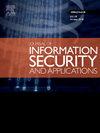Strengthening ICS defense: Modbus-NFA behavior model for enhanced anomaly detection
IF 3.7
2区 计算机科学
Q2 COMPUTER SCIENCE, INFORMATION SYSTEMS
Journal of Information Security and Applications
Pub Date : 2025-02-11
DOI:10.1016/j.jisa.2025.103990
引用次数: 0
Abstract
The rise of the Internet of Things (IoT) has significantly transformed Industrial Control Systems (ICS) by increasing their dependence on interconnected devices for automating processes. This growing integration of IoT technologies within ICS has heightened concerns about security and privacy, underscoring the importance of protecting sensitive data. This paper addresses the challenge of detecting anomalies within ICS environments that utilize the Modbus protocol. Modbus requests are encapsulated in Modbus frames, which direct devices on the specific actions to undertake. Thus, the sequence of Modbus frames in network traffic serves as a comprehensive indicator of device behavior on the network. To tackle this challenge, we introduce a novel approach for anomaly detection by modeling device interactions on the network through the analysis of Modbus frame sequences using a Non-deterministic Finite Automaton (NFA) framework, termed the Modbus-NFA Behavior Distinguisher (MNBD) model. The NFA framework is particularly effective for this purpose as it can represent multiple potential states and transitions within a network, thereby capturing the complexity and variability of network behaviors. This capability allows the MNBD model to detect deviations from normal behavior, identifying potential anomalies with high accuracy. Our MNBD model was evaluated against several existing ICS network traffic datasets. The results demonstrate that the Modbus-NFA approach not only surpasses traditional machine learning models but also outperforms sequence-based deep learning models. Additionally, cross-dataset testing reveals that the MNBD model exhibits superior generalization capabilities compared to deep learning-based approaches. These findings highlight the MNBD model’s potential as a robust tool for anomaly detection, advancing research and development efforts in ICS security.
加强ICS防御:用于增强异常检测的Modbus-NFA行为模型
物联网(IoT)的兴起大大改变了工业控制系统(ICS),增加了它们对自动化过程的互联设备的依赖。物联网技术在ICS中的日益融合,加剧了人们对安全和隐私的担忧,凸显了保护敏感数据的重要性。本文解决了在利用Modbus协议的ICS环境中检测异常的挑战。Modbus请求被封装在Modbus帧中,它指导设备执行特定的动作。因此,网络流量中Modbus帧的顺序可以作为网络上设备行为的综合指标。为了应对这一挑战,我们引入了一种新的异常检测方法,通过使用非确定性有限自动机(NFA)框架(称为Modbus-NFA行为区分器(MNBD)模型)分析Modbus帧序列,对网络上的设备交互进行建模。NFA框架对于这一目的特别有效,因为它可以表示网络中的多个潜在状态和转换,从而捕获网络行为的复杂性和可变性。该功能允许MNBD模型检测正常行为的偏差,以高精度识别潜在的异常。我们的MNBD模型针对几个现有的ICS网络流量数据集进行了评估。结果表明,Modbus-NFA方法不仅超越了传统的机器学习模型,而且优于基于序列的深度学习模型。此外,跨数据集测试表明,与基于深度学习的方法相比,MNBD模型表现出更好的泛化能力。这些发现突出了MNBD模型作为异常检测的强大工具的潜力,推动了ICS安全的研究和开发工作。
本文章由计算机程序翻译,如有差异,请以英文原文为准。
求助全文
约1分钟内获得全文
求助全文
来源期刊

Journal of Information Security and Applications
Computer Science-Computer Networks and Communications
CiteScore
10.90
自引率
5.40%
发文量
206
审稿时长
56 days
期刊介绍:
Journal of Information Security and Applications (JISA) focuses on the original research and practice-driven applications with relevance to information security and applications. JISA provides a common linkage between a vibrant scientific and research community and industry professionals by offering a clear view on modern problems and challenges in information security, as well as identifying promising scientific and "best-practice" solutions. JISA issues offer a balance between original research work and innovative industrial approaches by internationally renowned information security experts and researchers.
 求助内容:
求助内容: 应助结果提醒方式:
应助结果提醒方式:


